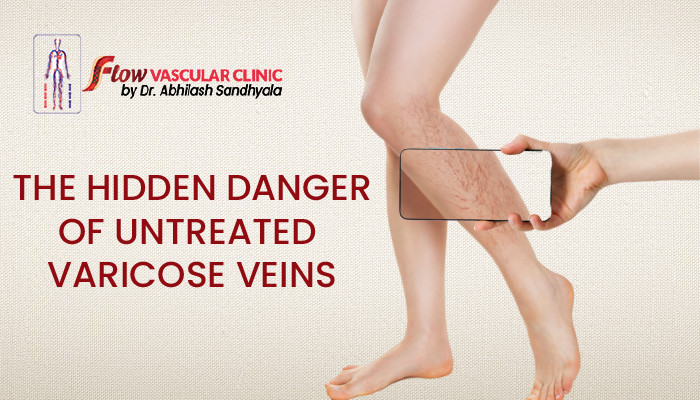Painful varicose veins are often a sign of something more serious, such as a skin infection or a blood clot. Painful varicose veins can persist for a long time and can get worse. As they worsen, you can get complications as a result. There are certain hidden dangers of untreated varicose veins, which is what we’ll focus upon in this article…
- Leg swelling: Fluid from the blood can seep into the surrounding tissues, as pressure builds within the veins. You should be able to recognize the signs of swelling. These could include a tight sensation in your skin or an impression left in your skin when you remove your socks and shoes. In severe cases, your leg may become very swollen and your shoes may not fit. A clear and yellowish fluid may leak out from your skin. If the swelling persists, it can result in hardening of the skin and a change in skin colour. If you practice leg elevation and wear compression stockings, these symptom could improve.
- Chronic Venous Insufficiency (CVI): This condition occurs when blood pools in the veins of your legs. This makes it difficult for blood to circulate from your legs to your heart. This inadequate circulation causes fluid to accumulate in the legs, a condition called oedema. If you have CVI, you may experience cramps, pain, and weakness in your legs. It could possibly also affect the extent of your mobility and the quality of your life.
- Venous ulcers:Varicose veins cause swelling, which results in skin changes. This means that the skin is less likely to heal after even a minor injury. This happens because the swollen tissue limits the flow of oxygen and nutrients to the involved tissue. The constant tension on the tissues can also delay or prevent healing, creating ulcers that do not heal. If you want these venous ulcers to heal you need to reduce the swelling.
- Skin infection (Cellulitis): Swollen varicose veins interfere with the body’s natural defence against infection. Bacteria that are normally present on the skin get into the body, causing a skin infection called cellulitis. There will generally be a distinct area of redness and warmth at the site of the skin infection with an increase in swelling. In severe cases, there may be pus, blisters, and an overall sense of malaise. There may also be fever with chills, which takes place in most infections. If not treated immediately with medication, this infection could be life-threatening.
- Bleeding: If you have varicose veins that are swollen, there is a larger-than-usual amount of blood right beneath the surface of the skin. If your varicose vein is hit or cut, there could be a significant amount of bleeding, more than what would be usual. Also, if the skin is not broken, there could be distinct bruising. It could take longer than normal for the bleeding to stop, especially if the injury is large.
- Thrombophlebitis: If you have varicose veins, you may develop blood clots in the veins. These blood clots result in the area becoming painful and warm to the touch. Also, the vein could become hard.
- Deep Vein Thrombosis (DVT): In about 25% of people who develop blood clots due to varicose veins, these blood clots will develop in their deep veins. This is called Deep Vein Thrombosis, and it is a serious medical condition that requires immediate treatment. The leg becomes swollen, red, warm, and painful. The biggest risk of DVT is that the blood clot may break off and travel to the lungs resulting in a life-threatening condition called pulmonary embolism.
- Lipodermosclerosis: This is stiffening or hardening of the leg tissues. This occurs when the tissues of the leg are left untreated and inflamed for a very long period of time. This results in the tissues becoming firm and heavy. You may also feel that your legs are becoming increasingly tender, making it difficult to either relax or move.
If you have varicose veins, it is imperative that you get them treated by the right vascular surgeon. One such surgeon is Dr. Abhilash Sandhyala of the Flow Vascular Clinic, based in Hyderabad, India. He has treated thousands of cases of varicose veins extremely successfully, using a procedure called Endovenous Laser Treatment (EVLT).
Dr. Sandhyala will use a laser fiber passed through a catheter inside your vein. The laser energy will seal the faulty vein, with blood flow being redirected to the healthy veins. This entire process of varicose veins treatment takes about an hour. As this procedure is minimally invasive, it will not be very painful. Also, this procedure has minimal recovery time. All patients are encouraged to walk and to resume their daily activities on the same day of the procedure.
So, if you have varicose veins, do not leave them untreated. There are certain dangers of varicose veins left untreated. Do consult with Dr. Sandhyala, who will suggest the treatment for your varicose veins that is right for you. You may go through the EVLT procedure or then combine this with another procedure.
Dr. Sandhyala is not only extremely skilful, he is also extremely compassionate and caring. He will answer all of your questions and resolve any and all your doubts regarding your varicose veins treatment. So, go ahead, do not delay any longer and consult with Dr. Sandhyala as soon as you possibly can!
For more information about varicose veins treatment, as well as the treatment for DVT, or other vascular conditions, contact Dr. Abhilash Sandhyala at (+91) 9989649498 or 9959033037, or at contact@drabhilash.com or visit our website at www.drabhilash.com

